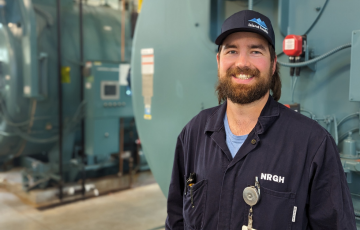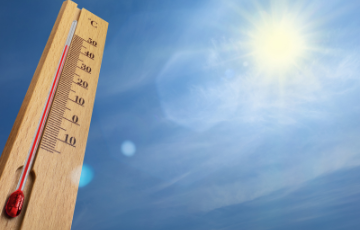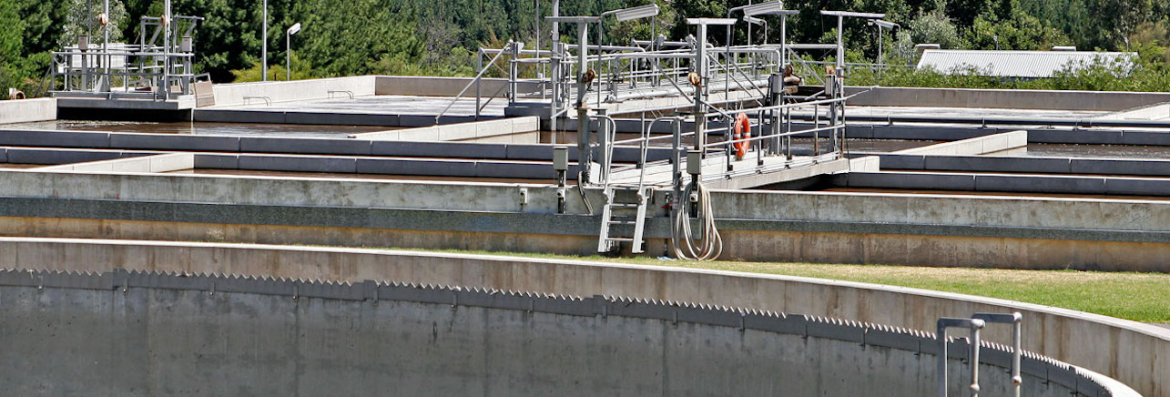Onsite Sewage Disposal
Any home or building that is not connected to a municipal or city sewage system needs a safe method of treating and discharging sewage.
Requirements for sewerage systems
Island Health's role in onsite sewage is to ensure all buildings with indoor plumbing have a sewerage system that is in compliance with the Sewerage System Regulation.
Some of the key requirements include:
- construction and maintenance of a sewerage system with a daily design flow of less than 22,700 litres per day must meet the Sewerage System Regulation requirements including:
- single family residence or duplexes
- sewerage systems which service different structures on a single parcel of land
- systems that serve one or more parcels on strata lots or on a shared interest of land
- larger waste water systems of 22 700 litres per day or more must meet the Municipal Wastewater Regulation requirements under the Environmental Management Act
- every owner who wants to construct, alter or repair a sewerage system must retain the services of an Authorized Person who may be a:
- before the construction, alteration, or repair of a sewerage system an Authorized Person must submit information respecting the designed details of the system. Sewerage System Form
- within 30 days of completing construction of the sewerage system the Authorized Person must submit to the Health Authority a signed letter certifying that system meets the requirements of the Sewerage System Regulation. Submit your letter by location / Letter of Certification
- when it is not possible to install a sewerage system on a parcel of land, the owner may choose to install a sewage holding tank.
Holding Tank Application and Holding Tank Construction Guidelines
Subdivision of Land
When subdivision applications are referred to Island Health the district Environmental Health Officer will assess the applications and provide comments back to the Approving Officer in regards to the land parcels suitability in supporting onsite sewage disposal using Subdivision Standards.
Health Protection plays an important role in land development providing input on water and wastewater infrastructure. However, we are also willing to offer recommendations from the broader “Healthy Built Environment” perspective to promote healthy community planning.
Have a complaint, concern, or would like to obtain copies of sewerage records for a particular property?
If you have a health and safety concern or complaint about an onsite sewage issue, please contact your local health protection office. To request sewerage records, please use our Request for Release of Information form; there is a $50.00 fee per property.
Land Use FAQs
Q: What are the requirements for building a septic system?
A: Nowadays septic systems are called sewerage systems and they fall under the BC Sewerage System Regulation. The Sewerage System Regulation (SSR) requires the construction of systems to be completed by Authorized Persons. A copy of the Sewerage System Regulation can be found at http://www.bclaws.ca/EPLibraries/bclaws_new/document/ID/freeside/22_326_2004
More information on the sewerage system process can be found at the Ministry of Health website: Ministry of Health - Province of British Columbia
Q: Who is an Authorized Person (AP)?
A: An Authorized Person (AP) is either a Professional or a Registered Onsite Wastewater Practitioner (ROWP). Both Professionals and ROWPs have training and experience in designing and installing sewerage systems.
Q: What is a professional and what kinds of systems can they construct?
A: A professional is someone who has professional status and is competent in the area of sewerage system design. Professionals are typically engineers or geoscientists. The BC Association of Professional Engineers and Geoscientists maintains a list of professionals who do sewerage system work: https://www.apeg.bc.ca/Member-Directories/Professionals-for-Sewerage-System-Regulation.
A professional can design and install type 1, 2 and 3 systems with a daily design flow up to 22,699 litres per day.
Q: What is a ROWP and what kinds of systems can they construct?
A: A ROWP is a Registered Onsite Wastewater Practitioner. The Applied Science Technologists and Technicians Association of BC issues ROWP’s their registration status. ROWP’s can design and install Type 1 and 2 systems which have a daily design flow less than 9100 litres per day. ROWP’s can be registered in up to five different categories. They can be planners, installers, maintenance providers, private inspectors (commercial) or private inspectors (residential). It should be noted that many ROWPS are registered in more than one category. For more information on ROWP’s go to the ASTTBC website: https://asttbc.org/.
Q: How do I find a ROWP?
A: To find a ROWP go to the ASTTBC website:https://asttbc.org/registrants/registrant-directory/#.
Q: How do I find a professional?
A: To find a professional go to the APEGBC website: https://www.apeg.bc.ca/Member-Directories/Professionals-for-Sewerage-System-Regulation. It should be noted that this website only lists those professional who have listed their sewerage services with APEGBC. There may be other professionals that provide sewerage system services. To find those you could contact a ROWP or use the local yellow pages to search engineering firms.
Q: What about Composting Toilets? What are they and who can install them?
A: A composting toilet is considered a type of sewerage system. Therefore, an owner who wants to construct or use a composting toilet must hire an Authorized Person (AP) to file the necessary documentation to the Health Office and either supervise or construct (install) the composting toilet on the owners property. AP’s constructing a composting toilet sewerage system can follow the BC Ministry of Health Manual of Composting Toilet and Greywater Practice
Q: An AP is building me a new sewage system. How do I know it’s the right type or size for my needs?
A: You can ask the AP how the design of the proposed sewerage system and the site conditions compare to standard practice and to provide a list of expenses for the components of the system. All AP’s are required to construct sewerage systems in accordance with standard practice. The BC Ministry of Health maintains the BC Sewerage System Standard Practice Manual which is but one standard practice. The BC SPM can be found at the following BC MOH website: https://www2.gov.bc.ca/assets/gov/environment/waste-management/sewage/spmv3-24september2014.pdf . It should be noted that ASTTBC expects ROWP’s to follow the standards set out in this manual. Professionals can choose to use this design manual or they can choose another method but if they do choose another method it still must be a method that would be considered standard practice. You can also compare quotes from multiple AP’s to help ensure you are getting a system that will meet your needs at a fair price.
Q: Why maintain my sewage system?
A: Not maintaining a sewerage system is one of the leading causes of premature system failure. Repairs to systems are often much more expensive than the maintenance of the existing system. Repairs to failed systems often involve the need to construction brand new systems. Sewage system failures, with sewage ponding on the ground surface are considered health hazards and can pose a threat to the environment or drinking water supplies. The owner is required by law to remedy a failing system as soon as possible. Owners of sewerage systems constructed under the Sewerage System Regulations should have a maintenance plan provided by the AP at the time the system was constructed. Owners of these systems should adhere to that maintenance plan. Owners of older systems will not have a maintenance plan but could obtain the services of an AP maintenance provider to develop a maintenance plan for them.
Q: How do I repair my sewage system?
A: Your first step should be to contact an Authorized Person. If sewage is ponding on the ground surface or entering a drinking water supply you should be reporting it to an Environmental Health Officer. You are not permitted to repair your system unless supervised by an AP.
Q: What are the design criteria for constructing sewerage systems?
A: All AP’s are required to construct sewerage systems in accordance with standard practice. The BC Ministry of Health maintains the BC Standard Practice Manual which is but one standard practice. The BC SPM can be found at following BC MOH website: http://www2.gov.bc.ca/gov/topic.page?id=C2F3DBA2AF8C4B9DAB7FC2C3A87D63E3. It should be noted that ASTTBC expects ROWP’s to follow this manual. Professionals can choose to use this design manual or they can choose another manual but if they use another standard it still must be a one that would be considered standard practice.
Q: As a homeowner can I build my own sewerage system?
A: Yes, as a homeowner you can build your own sewerage system but an AP must still design the system, submit Filing documents to the Health Authority and supervise the systems construction.
Q: What information does the AP need to submit to the Health Authority before construction of the system can begin?
A: Prior to constructing a sewerage system an AP must “File” information with the Health Authority. This information submission includes a Filing form, plans and specification of the sewerage system, a property site plan, any applicable covenants, easements or hydrogeological reports. The Filing form includes information about the owner, AP, property location, site conditions, type of sewerage system being constructed and the type of structure the system will be serving.
Q: What information is required in the Letter of Certification and when can I use my new sewage system?
A: The letter of Certification (LOC) is a document signed by the AP saying that; the AP has lawfully constructed the sewerage system, construction of the sewerage system is completed, the system if used as intended will not cause or contribute to a health hazard and that the daily design flow is less than 22,700 litres per day. It also includes an as build diagram of the sewerage system and a maintenance plan prepared by the AP. It is a legal requirement that the LOC be submitted within 30 days of completing construction. The sewerage system cannot be put into use until the LOC is submitted to the Health Authority.
Q: Do I need to hire an AP for minor repairs to my sewerage system?
A: Yes, all repairs and maintenance to sewerage systems must be performed by authorized persons or under the supervision of an authorized person.
Q: Do I need to submit Filing documents for minor repairs to my sewerage system?
A: No, but you should check to ensure the repairs are minor and that they do not require the submission of Filing documents. Types of repairs that do not need Filing documents include broken lid on the distribution box, broken effluent pump, replace float switch, installation of an effluent filter or replacing a short section (10 feet) of crushed distribution line. Examples of repairs that require Filing documents to be submitted include, replace distribution field, replace septic tank or changing from gravity distribution to pressure distribution.
Q: I’m changing the use of my building and am not sure if I have to upgrade the sewerage system?
A: If there is a potential increase in the daily sewage flow you likely have to update the sewerage system. The Sewerage System Regulation requires the owner of a building to ensure the sewerage system is designed to accommodate sewage from that building. The need to upgrade the sewerage systems can result from change of building size (increased square footage or increase in number of bedrooms), change in sewage flow (adding more seats to a restaurant) or changing sewage strength (corner store changing to a restaurant). If the change to the building requires a building permit the Building Inspection Authority may require you to obtain a report from an AP to assess the system’s capacity to accommodate the building changes. If you are making changing to a commercial establishment such as a restaurant the local Environmental Health Officer may require you to obtain a report from an AP to assess the system’s capacity to accommodate the building changes. If you are in doubt you can contact an AP or contact an Environmental Health Officer.
Q: If I hire an AP to assess my sewage system what kind of report should I receive?
A: Generally there are two kinds of assessment reports that an AP can perform. They are Compliance Inspection Reports and Performance Inspection Report. A compliance inspection report would typically be used to support a building permit application. A performance inspection report would typically be used during a property sale. You can find more information on these types of inspections and assessments at the following ASTTBC website: https://asttbc.org/wp-content/uploads/2021/09/ROWP-Practice-Guidelines-1.pdf
Q: I’m looking to purchase a home with a sewerage system what should I look for?
A: You should first contact an AP to do an inspection and provide you with a report on the status of the existing sewerage system. Secondly, you should tell the AP exactly what your plans are for the property i.e. number of people who will live in the house, future plans for expanding the building or any planned in-home small businesses. It is unlikely that any sewerage system will last forever and that an AP will predict the useful life expectancy of the existing sewerage system so you could ask the AP to identify a suitable replacement area for a new sewerage system. With respect to any upgrades or replacements of existing systems you could obtain a quote for those costs as new sewerage systems or repairs to existing systems can be expensive.
You can check Health Authority records to compare file records to what is installed. You can require the current owner to provide you with a declaration of all work, including maintenance, done on the system.
Q: Does the Health Authority approve the AP’s sewerage system design and Filing documents?
A: No, the Health Authority does not approve the sewerage system design nor does the Health Authority routinely review Filing documents for their technical merit. The Health Authority’s role is to receive Filing documents from APs and to ensure those documents meet the minimum submission criteria i.e. did the AP correctly complete the Filing form, provide plans and specification and provide a site plan drawn to scale. It is the full responsibility of the AP to ensure the sewerage system design meets standard practice and to ensure that the system is suitable for its intended purpose.
Q: How do I make a complaint about an AP?
A: For health based complaints respecting malfunctioning sewerage systems you can contact the Health Authority Environmental Health Officer. For complaints regarding professional practice you can contact the AP’s professional association.
For complaints about professionals contact APEGBC: https://www.apeg.bc.ca/For-Members/Discipline-and-Enforcement/Submit-a-Complaint
For complaints about ROWP’s contact ASTTBC: https://asttbc.org/public/complaint-submission/
Q: How do I make a complaint about my neighbour’s failing sewage system or of a system being constructed illegally?
A: For either of these situations you can contact an Environmental Health Officer. Be prepared to provide the Environmental Health Officer with specifics such as the property address. It is an offence to construct or repair a sewerage system without proper qualification, without first submitting Filing documents, to discharge sewage onto the ground surface, into a body of water or into a source of drinking water.
Q: How do I find out what kind of sewage system is on my property or where it is located?
A: The Health Authority may have records of your sewerage system. The older the system the less likely the Health Authority will have records on file. There should be records for all systems that are 2005 or newer and for most system 1990 to 2005. You may also try contacting the previous home owner or the local building inspection department to see what records they may have. If there are no records you can hire an AP to locate the system and identify its components. They may even be able to provide you with a maintenance plan if you do not already have one.
Q: I have a restrictive covenant on my property saying I have to build my sewerage system in a specific spot etc. Can I get this covenant removed or relocated?
A: In some cases it is possible to have the covenant removed or relocated. You should start the process by first contacting your local Environmental Health Officer. The terms of the covenant are legal requirements and you should be prepared to follow those as there is no obligation on the covenant grantee to change the terms of the covenant.
Q: What happens when a septic system fails?
A: A failing sewage system typically results in sewage ponding on the ground surface. The receiving environment (subsurface soil) is saturated and/or the soil pores are clogged. This can be the result of a number of things such as; the system has not been maintained properly, the system has been overused, the system is coming to the end of its useful life expectancy, the system was too small for the amount of sewage it received, the system was designed or installed improperly. It can even be a failure to one of the systems components such as a broken effluent pump in a pump chamber. In any case it is the responsibility of the owner to repair the system as soon as possible.
Q: How can I tell if my septic system is failing?
A: Initially, failures can begin with slowly draining fixtures such as sinks, showers and tubs. It is likely that the receiving environment (soil) can no longer accept the sewage. The soil is clogged from the sewage particles and can no longer drain fast enough to receive new effluent. Prolonged failures are evident by sewage ponding on the ground surface. The ponding effluent will be quite odorous with a grey color. Flushing non toxic dyes down the toilet will confirm that the ponding liquid is sewage. Keep pets and people away from the ponding sewage and contact an AP to have the system repaired as soon as possible.
Q: Should I use septic tank additives, I hear they are good?
A: No, septic tank additives are not recommended as there have been no proven benefits to their use. In some cases septic tank additives can actually harm your sewerage system. Washington State provides excellent information on septic tank additives. https://doh.wa.gov/sites/default/files/legacy/Documents/Pubs//337-025.pdf or https://actat.wvu.edu/files/d/39a22099-e56f-4213-99fe-08a9aed6210c/sfqw02.pdf
Q: Can I use my grey water to flush toilets?
A: You can use grey water to flush toilets but you should follow the BC building code and check with your local building inspection authority before undertaking this. It is very important that you ensure potential cross connections with potable water lines are properly controlled and that there is no opportunity for the potable water supply to be contaminated. Grey water is considered sewage and when it leaves the building it must be disposed of in accordance with the sewerage system regulation.
Q: Can I use my grey water to water my garden?
A: Yes, but it must be done using a sewerage system which is designed by an AP with Filing documents submitted to the Health Authority by the AP. The use of grey water for gardens should be restricted to non food crops such as flowers and the sewage effluent must be applied below the ground surface via a sewerage system. The discharge of grey water directly to the ground surface is illegal and constitutes an offence under the Sewerage System Regulation.
Q: Can I grow vegetables over my sewerage system?
A: No, the Health Authority does not recommend growing vegetables or other food crops over your sewerage system as the vegetables could become contaminated with sewage or the plant roots could interfere with the sewage distribution system. It is a much better and safer practice to simply plant grass over the distribution field and keep this area clear of larger plant roots. There are numerous agencies that provide best practice guidelines on sewage system maintenance…the Do’s and Don’ts. A few of these are:
US EPA: http://water.epa.gov/infrastructure/septic/septicsmart.cfm
Regional District of Nanaimo Septic Smart: http://www.rdn.bc.ca/cms.asp?wpID=1159
Q: Can I install an automatic underground lawn sprinkling system over my sewage distribution field?
A: No, you cannot install water lines over the sewage system as it presents a risk of sewage contaminating the drinking water supply and supplies excess water into the distribution field. Water lines must be kept at least three meters from the sewage distribution field.




